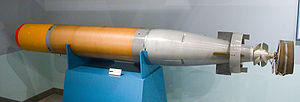Mark 44 torpedo
| Mark 44 torpedo | |
|---|---|

A Japanese built Mk44 torpedo at the Kanoya museum, Japan
|
|
| Type | Antisubmarine torpedo |
| Place of origin | United States |
| Service history | |
| In service | 1957-1967 (with United States Navy) |
| Used by | See Operators |
| Production history | |
| Designer | Naval Ordnance Test Station Pasadena General Electric |
| Designed | 1953 |
| Manufacturer |
General Electric Naval Ordnance Station Forest Park American Machine and Foundry |
| Variants | Mark 44 Mod 1 |
| Specifications | |
| Weight | 432 pounds (196 kg) |
| Length | 8.2 feet (2.5 m) |
| Diameter | 12.75 inches (32.4 cm) |
|
|
|
| Muzzle velocity | 123 metres per second (400 ft/s) |
| Effective firing range | 123 metres (135 yd) |
| Warhead | Mk 101 Mod 0, HBX-3 |
| Warhead weight | 75 pounds (34 kg) |
|
Detonation
mechanism |
Mk 19 type Mod 12 contact exploder |
|
|
|
| Engine |
Electric 30 horsepower (22 kW) |
|
Operational
range |
3.4 miles (5.5 km) |
| Maximum depth | 1,000 yards (910 m) |
| Speed | 30 knots (56 km/h; 35 mph) |
|
Guidance
system |
Helix search |
|
Launch
platform |
Destroyers and aircraft |
The Mark 44 torpedo is a now-obsolete air-launched and ship-launched lightweight torpedo manufactured in the United States, and under licence in Canada, France, Italy, Japan and the United Kingdom, with 10,500 being produced for U.S. service. It was superseded by the Mark 46 torpedo, beginning in the late 1960s. The Royal Australian Navy, however, continued to use it alongside its successor for a number of years, because the Mark 44 was thought to have superior performance in certain shallow-water conditions.
It has been deployed by many navies and air forces including the USN, Royal Navy, Royal Australian Navy and the Royal Air Force from various launch vehicles. These include long-range maritime patrol aircraft, e.g. P-3 Orion, RAF Nimrod, LAMPS and other embarked naval helicopters, ASROC missiles, Ikara missiles.
During the 1950s the US Navy ordered development of a new generation of lightweight anti-submarine torpedoes. Two programs were started, the EX-2A at the Naval Ordnance Test Station Pasadena (NOTS-Pasadena) and the EX-2B at General Electric Ordnance Department, Pittsfield, Massachusetts. The EX-2A was to have its counter-rotating propeller driven directly by an electric motor, while the EX-2B was to use a gas turbine connected to a gearbox.
After an accident with the proposed fuel for the EX-2B (Propyl Nitrate) the US Navy ordered the halting of its use. This resulted in the EX-2B development team shifting to an electric motor using the design for a jet engine starter motor as the basis to give the high torque and RPM the counter-rotating gearbox needed. The shroud design around the control surfaces of the EX-2B was also redesigned, as it was discovered that having the shroud around the control surfaces themselves reduced their effectiveness, as a result the length of the shroud was reduced.
...
Wikipedia
